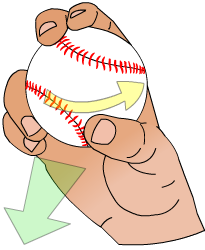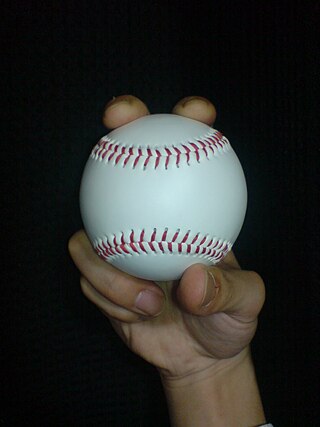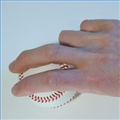In the game of cricket, a googly refers to a type of delivery bowled by a right-arm leg spin bowler. It is different from the normal delivery for a leg-spin bowler in that it is turning the other way. The googly is not a variation of the typical off spin type of delivery, in that the cricket ball is presented from the bowler's hand in such a way that once the ball pitches; instead, it deviates in the opposite direction of a leg spinning type of delivery. It has also been colloquially referred to as the wrong'un, Bosie or Bosey, with the latter two eponyms referring to Bernard Bosanquet, the bowler who originally devised and began using the googly.

The fastball is the most common type of pitch thrown by pitchers in baseball and softball. Its distinctive feature is its high speed. "Power pitchers," such as former American major leaguers Nolan Ryan and Roger Clemens, rely the speed of the fastball to prevent the ball from being hit and throw fastballs at speeds of 95–105 miles per hour (153–169 km/h) (officially) and up to 108.1 miles per hour (174.0 km/h) (unofficially). As an alternative to the fastball, pitchers can put movement on slower thrown balls, or throw them towards the inside or outside of home plate where batters cannot easily reach it.

In baseball, a slider is a breaking ball pitch that tails laterally and down through the batter's hitting zone. It is thrown at a speed that is lower than a fastball, but higher than the pitcher's curveball.

In baseball and softball, the curveball is a type of pitch thrown with a characteristic grip and hand movement that imparts forward spin to the ball, causing it to dive as it approaches the plate. Varieties of curveball include the 12–6 curveball, power curveball, and the knuckle curve. Its close relatives are the slider and the slurve. The "curve" of the ball varies from pitcher to pitcher.

A changeup is a type of pitch in baseball and fastpitch softball.

A split-finger fastball or splitter is an off-speed pitch in baseball that looks to the batter like a fastball until it drops suddenly. Derived from the forkball, it is so named because the pitcher puts the index and middle finger on different sides of the ball.

In baseball, a starting pitcher or starter is the first pitcher in the game for each team. A pitcher is credited with a game started if they throw the first pitch to the opponent's first batter of a game. Starting pitchers are expected to pitch for a significant portion of the game, although their ability to do this depends on many factors, including effectiveness, stamina, health, and strategy.

In baseball, the pitch is the act of throwing the baseball toward home plate to start a play. The term comes from the Knickerbocker Rules. Originally, the ball had to be thrown underhand, much like "pitching in horseshoes". Overhand pitching was not allowed in baseball until 1884.

Mordecai Peter Centennial Brown, nicknamed "Three Finger Brown" or "Miner", was an American Major League Baseball pitcher and manager during the first two decades of the 20th century. Due to a farm-machinery accident in his youth, Brown lost parts of two fingers on his right hand, and in the process gained a colorful nickname. He turned this handicap into an advantage by learning how to grip a baseball in a way that resulted in an exceptional curveball, which broke radically before reaching the plate. With this technique he became one of the elite pitchers of his era.

A two-seam fastball is a pitch in baseball and softball. It is a variant of the straight fastball. The pitch has the speed of a fastball and can also include late-breaking action caused by varying the pressure of the index and middle fingers on the ball.

A four-seam fastball, also called a rising fastball, a four-seamer, or a cross-seam fastball, is a pitch in baseball. It is a member of the fastball family of pitches and is usually the fastest ball thrown by a pitcher. It is called what it is because with every rotation of the ball as it is thrown, four seams come into view. A few pitchers at the major league level can sometimes reach a pitch speed of over 100 mph. It is often compared with the two-seam fastball.

In baseball, a breaking ball is a pitch that does not travel straight as it approaches the batter; it will have sideways or downward motion on it, sometimes both. A breaking ball is not a specific pitch by that name, but is any pitch that "breaks", such as a curveball, slider, or screwball. A pitcher who primarily uses breaking ball pitches is often referred to as a junkballer.

In baseball, a circle changeup or circle change is a pitch thrown with a grip that includes a circle formation, hence the name circle changeup. The circle is formed by making a circle with the index finger, holding the thumb at the bottom of the ball parallel to the middle finger and holding the ball far out in the hand. The ball is thrown turning the palm out.

In baseball, a cut fastball or cutter is a type of fastball that breaks toward the pitcher's glove-hand side, as it reaches home plate. This pitch is somewhere between a slider and a four-seam fastball, as it is usually thrown faster than a slider but with more movement than a typical fastball. Some pitchers use a cutter to prevent hitters from expecting their regular fastballs. A common technique for throwing a cutter is to use a four-seam fastball grip with the baseball set slightly off center in the hand. A batter hitting a cutter pitch often achieves only soft contact and an easy out due to the pitch's movement keeping the ball away from the bat's sweet spot. The cutter is typically 2–5 mph slower than a pitcher's four-seam fastball. In 2010, the average pitch classified as a cutter by PITCHf/x thrown by a right-handed pitcher was 88.6 mph; the average two-seamer was 90.97 mph.
In baseball, an off-speed pitch is a pitch thrown at a slower speed than a fastball. Breaking balls and changeups are the two most common types of off-speed pitches. Very slow pitches which require the batter to provide most of the power on contact through bat speed are known as "junk" and include the knuckleball and the Eephus pitch, a sort of extreme changeup. The specific goals of off-speed pitches may vary, but in general they are used to disrupt the batter's timing, thereby lessening his chances of hitting the ball solidly or at all. Virtually all professional pitchers have at least one off-speed pitch in their repertoire. Despite the fact that most of these pitches break in some way, batters are sometimes able to anticipate them due to hints that the pitcher gives, such as changes in arm angle, arm speed, or placement of fingers.

A gyroball is a type of baseball pitch used primarily by players in Japan. It is thrown with a spiral-like spin, so that there is no Magnus force on the ball as it arrives at home plate. The gyroball is sometimes confused with the shuuto, another pitch used in Japan.
In baseball, a sinker or sinking fastball is a type of fastball which has significant downward and horizontal movement and is known for inducing ground balls. Pitchers capable of utilizing the sinker are able to throw the pitch almost exclusively, as it forces weak contact and ground balls, allowing them to rely less on secondary pitches in order to change speeds. While coaches agree that this pitch is very similar to the two-seam fastball, a two-seamer tends to have more lateral movement than a sinker. In either case, the pitch is thrown in a two-seam orientation and has a gyro angle far from 0 degrees, leading to seam-shifted wake effects that cause downward and lateral movement compared to a four-seam fastball.
The shuuto (シュート) or shootball is a baseball pitch. It is commonly thrown by right-handed Japanese pitchers such as Hiroki Kuroda, Noboru Akiyama, Kenjiro Kawasaki, Daisuke Matsuzaka, Yu Darvish and Masumi Kuwata. The most renowned shuuto pitcher in history was Masaji Hiramatsu, whose famous pitch was dubbed the razorshuuto because it seemed to "cut the air" when thrown.

The 12–6 curveball is one of the types of pitches thrown in baseball. It is categorized as a breaking ball because of its downward break. The 12–6 curveball, unlike the normal curveball, breaks in a downward motion in a straight line. This explains the name "12–6", because the break of the pitch refers to the ball breaking from the number 12 to the number 6 on a clock. While the 11–5 and 2–8 variations are very effective pitches, they are less effective than a true 12–6, because the ball will break into the heart of the bat more readily.












